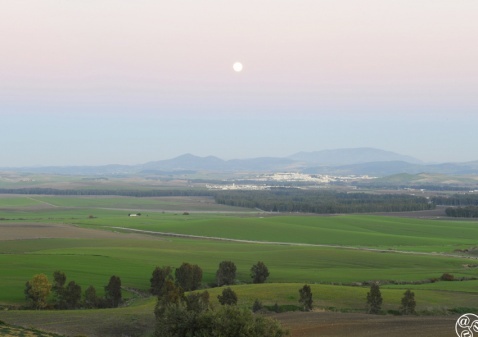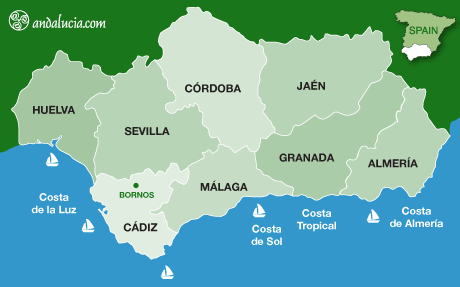
The remote village of Bornos |
|
The ancient village of Bornos, on the Ruta de los Pueblos Blancos, is some 25 kilometres to the north-east of Arcos de la Frontera, on the road to Villamartin. Surrounded by undulating countryside with lush green meadows, it lies in a prime position on the banks of a large reservoir fed by the River Guadalete, an important tributary of the Guadalquivir.
Bornos has been settled since the Palaeolithic era. Stone tools used for hunting dating back 30,000 years have been found in the area. A magnificent bronze sword, made in the 9th century BC, has also been discovered here and is now exhibited in the Archaeological Museum of Jerez de la Frontera. It was a significant centre for the Romans whose stone sculptures of lions have been uncovered along with other remains from their settlement, Carissa Aurelia, just three kilometres from the present town. Subsequently, a fortified tower was built by the Moors when they arrived around the 10th century, the Castillo de Bornos, ruins of which can still be seen.
Book your stay in Andalucia Now!
It was during the Renaissance that the village of Bornos became well known, with many buildings of that epoch still in evidence. Perhaps the most important is the Monastery of Santa María del Rosario, founded in 1505, whose cloister with its 56 marble columns and open-worked stone is well worth a visit. Other 16th-century monuments include the Colegio de la Sangre, built to house gentlemen, noblemen and others of ‘true blood’; the Convento de San Bernardino, of which only the walls and part of one tower remain; the Ermita del Calvario with an unusual triangular façade; and La Logia, an open-air gallery and museum originally created by the gentlemen of Bornos as a place to entertain their business colleagues. The loggia lies in the Jardines del Palacio de los Ribera, one of the few remaining Renaissance gardens in Andalucia, now officially declared a Site of Cultural Interest.
Over the centuries and still important today is the artisan work in Bornos focusing on articles made from esparto grass, willow, palm leaves, canes and reeds, in particular a wide variety of baskets. All these natural materials are gathered locally from the banks of the reservoir and from the rivers and streams that abound in the area. Olive wood and leather are also crafted, and ceramics are produced.
The village has its own robust cuisine based on local produce. There is a mouth-watering asparagus soup called abajao and a variety of stews, especially the famous berza made with chick peas and black pudding. Pork products, such as chorizo and morcón, are also well worth tasting.
Bornos celebrates its annual fair in the second week of September and the day of its patron saint, María Santísima del Rosario, on the first Sunday in October. Since 1980 it has attracted rock music fans from far and wide with the Festival del Lago that usually takes place in July.
